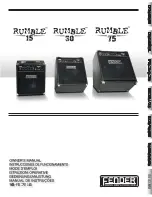
The output tubes will also age unequally (much like car tires), so some may adjustment may
be needed through out the tubes' life to keep them in balance. Although it's not necessary to
keep the tubes perfectly balanced, it will keep the amp putting out maximum power with the
least amount of hum.
If adjustment is necessary, first loosen the outer lock-nuts on the bias adjustments. Make
move the control with a flat-head screwdriver (a guitar pick works well too), while monitoring
the number on the multimeter. You may have to adjust both controls back and forth until they
are balanced because they are somewhat interactive.
Tube life and troubleshooting
Output tubes (V4 and V5 – See tube chart on pg. 10) generally produce a good strong sound
for 6 months to a year when played regularly, then they may become dull sounding, and/or
the amplifier may begin to loose some power. Output tubes may last much longer depending
on how hard the amp is played. Sometimes they die gently, sometimes abruptly causing a fuse
to blow, which in turn protects the amplifier from further damage. Output tubes may also
become microphonic like preamp tubes.
It's sometimes possible to see which power tube(s) is damaged. If necessary, remove the
output tubes to inspect them (Remove power cord, allow tubes to cool, then grab by the
plastic base, and gently pulling up in a circular motion). Here are things to look for:
•
Shiny silver area on top of tube turns white.
•
Burned spot on the large gray structure inside the tube.
Sometimes a output tube or preamp tube will become “microphonic” when something
becomes physically loose inside the tube's glass envelope. In turn, this noise then gets
amplified through the speaker. The noise can be anything from static, a high-pitched ringing,
or intermittent sputtering noises. This is usually exacerbated by vibration from the speaker
cabinet. If you think a tube may be microphonic, try isolating the amplifier from the speaker
cabinet.
Tip: If you think you have a microphonic tube, you can very gently tap on each tube with a pencil's
eraser to see if the sound becomes worse or changes. All tubes will amplify the sound a little,
especially preamp tubes. But for example, if you hear an intermittent ringing sound and tap each
tube to find V1 is causing the ringing to start and stop, you can be sure it's the problematic tube!
In general preamp tubes (V1, V2, and V3 see tube chart on pg. 10) can last many years, and
usually become microphonic before wearing out or failing.
Changing preamp tubes
6
Содержание Hellhawk 50W
Страница 1: ...1...



























